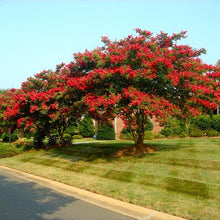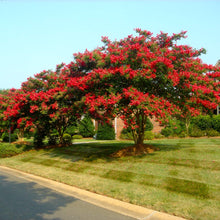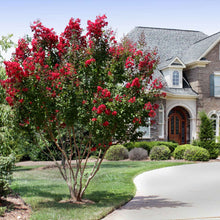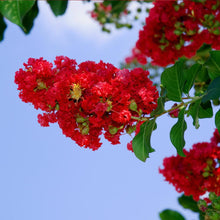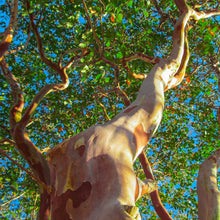
Bright Red Blooms up to 6 months a year
* Created to provide bright red blossoms
* Grows 3-5 ft. per year!
* Adaptable to various soil types
Intense red flowers will attract everyone's attention. Bright, feathery blooms last from spring to fall.
History
The Arapaho Red Crape Myrtle - bred at the National Arboretum by some of America's best horticulturists - was created especially to give you bright red blooms.
Remarkably, horticulturists around the country generally agree that the new Arapahoe is the most disease resistant crape myrtle available, making it an excellent selection that requires no messy spraying - just months of candy red blooms to delight and amaze.
Perfect in Any Setting
As a barrier or tree hedge, Arapahos are one of the faster growing red Crape Myrtles...shooting up to 3-5 ft. per year.
Easily adaptable to any landscape - including yours - these trees offer spectacular color in any soil. Thrives in Growing Zones 7-9.
Be sure to plant your Arapaho Crape Myrtle in full sun. If they get too much shade, the bright red color may fade.
Because your trees are young, they may arrive with deep pink or fuchsia blooms. If this happens, don't worry. Your Arapahos will display bright red blooms the next summer.
Planting & Care
The Arapaho Crape Myrtle (Lagerstroemia indica 'Arapaho') is a beautiful summer blooming tree designated for USDA growing zones 7-9. This full sun lover reaches a mature height of 15-25 feet tall, 10-20 feet wide and can take temperature drops as low as 10 degrees fahrenheit once established. The Arapaho is a disease/drought resistant crape but may need a little more water during times of excessive heat or drought. The summer season will deliver an explosion of bright red blooms throughout the canopy that you can enjoy all the way into the beginning of Autumn. Arapaho crapes are fairly quick growers pushing out about three feet per year.
Choosing a location: Crapes are FULL SUN lovers so try and find a spot where they will get as much sun as possible. Without the proper exposure your blooming will be substantially reduced or it may not bloom at all. The Arapaho is very adaptable to many soil types so just be sure that the area you’re looking to plant has adequate drainage when watering.
Planting directions:
1) After you have found your planting area, make your hole twice as wide as the root ball and just as deep.
2) Carefully remove the myrtle’s root ball from the container. Lightly tapping the container around the bottom will help free it up without causing too much damage to the root system.
3) Lightly comb your hands over the root ball to free up the roots a bit before planting.
4) Place your tree in the hole and make sure that the root crown (where the root ball meets the trunk(s) of the tree) is level with the soil surface. Crapes need to be able to pull oxygen into their root systems so covering them too much may inhibit their growth.
5) Tamp down the soil lightly as you backfill the hole to prevent air pockets from forming and then water after you’ve finished to settle the soil.
6) Mulch the area around the tree to conserve water moisture and deter competing weeds and grasses from growing.
Watering: Myrtles are quite drought tolerant but may need a bit more attention with watering during the hot summer season. Depending on your soil, there may need to be more frequent waterings, especially those with very sandy soils. After planting, water regularly to start. If the climate is hot you may need to water up to five times weekly especially in lighter soils. During the cooler seasons you’ll only need to water once weekly. Proper soil moisture is important in the hot season so that you’ll have a healthier tree and better looking blooms.
Pruning: Crape pruning is always a “mixed bag” if asking anyone when and how to prune. “Crape murder” is a common term heard with those who go far beyond what is necessary when trimming their myrtles. Prune in the late winter before any of the growth begins. If done in the late fall you will jeopardize the tree’s dormancy state which can lead to the tree dying. Sterilize your cutting tools with rubbing alcohol to ensure no pathogens infect the tree and always make your cuts at a 45 degree angle.
Some prefer to chop off all of the branches at a uniformed height every year leaving the stubs for the winter season that form a ball of growth in the springtime. This is good for height control and a uniformed border but can commonly result in knobby stems and bunchy growths that are easily susceptible to disease and aphid pests. This is where the term “crape murder” comes into play. Only a light pruning of the myrtle is needed to encourage plenty of blooms but “beauty is in the eye of the beholder” when it comes to choosing the shape of your crapes.
For a more graceful tree shape, remove all but 4-5 strong trunks and then remove the lateral branches around the bottom ½ of the tree. To encourage branching, make your cuts on the longer, leggy limbs. Try not to over prune too early, do your basic pruning then allow the tree to grow a bit and then continue shaping over time. Remove any damaged, diseased, or crossing branches during the late winter. Also be sure to remove any suckers or low growths to prevent your crape from looking more shrub-like.
Fertilizing: Your Arapaho Crape will greatly benefit from an annual feeding of a high nitrogen fertilizer such as a 20-10-10 slow release formula in the early spring season. If you care to fertilize twice, feed the tree again roughly two months later. Slow release fertilizer will cut back on sucker growths but be aware, excessive fertilizing can lead to tree and limb growth but will inhibit the blooms from forming due to excess amounts of nitrogen.




